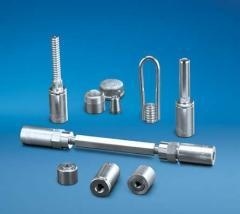JTMergens
Structural
- Oct 30, 2015
- 12
I am looking for peoples opinions as to how we should design cable railings. I have heard a lot of different philosophies from manufacturers, building officials, and other engineers, but the code has no clear direction. Where it becomes complicated is how much (if any) tension should be specified for the cables. If we specify a tension, we should be designing out end posts to be able to resit that tension. I talked with some individuals at Johnson Architecture, a supplier of cable railing hardware, and they first recommended 350# per cable. Not only is 350# of tension per cable impractical from a design standpoint, but it isn't very attainable in the field. Talking to some installers they tell me that their experience is that not only is it nearly impossible to get that kind of tension with a hand wrench (which is what is typically used to tighten the cables), but that by the time they get anywhere near the end posts start to deflect too much to achieve that level of tension. To design posts with 1400 plf (cables at 3" on center) for both stress and deflection is not feasible with the size of posts you see typically installed.
I talked with Johnson Architecture again to see where they got this 350# number from and the said it is based on a 4" sphere that cannot be based through with 50# of force. This means our required tension could be a function of out intermediate post spacing and our cable spacing. That's all well and good, but it still produces unreasonably high loads, and from what I can tell is not a method from the code that I could reference. The code does say you can't pass a 4" sphere, but does not specify a force, so does that mean taught cables 3" apart is good enough? If we just say taught do we need to worry about additional load to our end posts? The code does say you have to design your guardrails for a 200# point load at any location and that it can be spread over a 12" square area, so can we look at that to determine a resulting tension in the cables and design for that as opposed to designing for an installation tension?
Last of all, I have seen in public and been warned by an architect that these cables can start to sag from thermal expansion even if they are just out in the sun. So the question becomes at what point are we over-complicating the issue and basing designs of our posts on conditions that just don't occur in reality, and at what point are we over-simplifying and not providing adequate designs.
Most importantly, I am curious, how do you all design cable railings?
Thank you,
Josh
I talked with Johnson Architecture again to see where they got this 350# number from and the said it is based on a 4" sphere that cannot be based through with 50# of force. This means our required tension could be a function of out intermediate post spacing and our cable spacing. That's all well and good, but it still produces unreasonably high loads, and from what I can tell is not a method from the code that I could reference. The code does say you can't pass a 4" sphere, but does not specify a force, so does that mean taught cables 3" apart is good enough? If we just say taught do we need to worry about additional load to our end posts? The code does say you have to design your guardrails for a 200# point load at any location and that it can be spread over a 12" square area, so can we look at that to determine a resulting tension in the cables and design for that as opposed to designing for an installation tension?
Last of all, I have seen in public and been warned by an architect that these cables can start to sag from thermal expansion even if they are just out in the sun. So the question becomes at what point are we over-complicating the issue and basing designs of our posts on conditions that just don't occur in reality, and at what point are we over-simplifying and not providing adequate designs.
Most importantly, I am curious, how do you all design cable railings?
Thank you,
Josh


![[bigsmile] [bigsmile] [bigsmile]](/data/assets/smilies/bigsmile.gif)